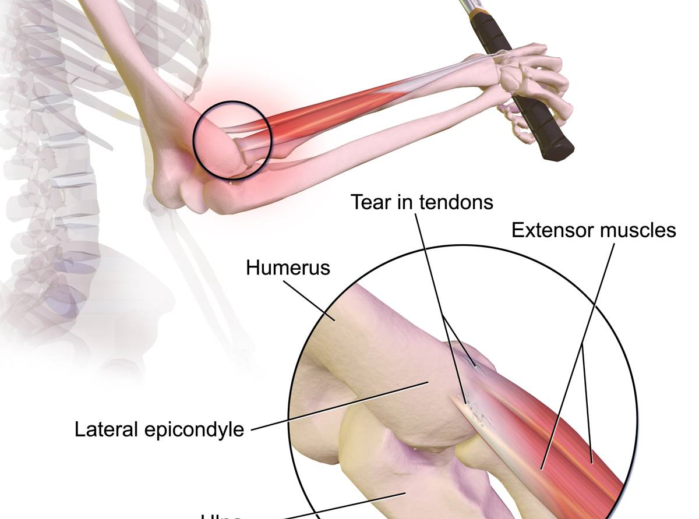When it comes to “tennis elbow”, many people think that it is caused by playing too much tennis, but this is not the case.
Why do you get “tennis elbow” if you don’t play tennis?
“Tennis elbow is a chronic soft tissue injury disease that causes pain in the elbow joint. It is a chronic soft tissue injury that causes pain in the elbow joint. Initially, the disease was often seen in tennis players who hit the ball backhanded, so it was also called “tennis elbow”.
“Tennis elbow is caused by inflammation at the start of the tendon, especially the radial carpal tunnel tendon, due to repeated contraction and pulling of the forearm extensor muscles, which can develop into a partial or even complete tear of the extensor tendon stop if not treated in time. Therefore, tennis elbow does not only occur in tennis players, but any activity that puts excessive repetitive stress on the lateral forearm muscles can cause this disease.
Who is at risk for tennis elbow?
“In addition to tennis players, tennis elbow is also an occupational disease of certain manual workers, such as those who engage in activities that involve repeated forceful extension and flexion of the elbow joint. This is because these people repeatedly pull their elbows and wrists too hard for a long time, or engage in a single action for a long time, resulting in excessive flexion and extension of the elbow joint, causing acute and chronic injury to the attachment point of the wrist extensor tendon (at the humeral epicondyle). Specifically, there are four major groups of people as follows:
- tennis, badminton, baseball, table tennis and other athletes.
- housewives, bricklayers, carpenters, repairers and other people who repeatedly use the elbow labor. Such people are prone to frequent use of the elbow work, so the chances of elbow damage increase, and in the long run can make some tendons and soft tissues attached to the elbow joint area, the occurrence of parts of the fiber tear, causing pain on the outside of the elbow joint.
- long-term computer work, office workers, white-collar workers, teachers.
- middle-aged and elderly. This group of people because of age, the body functions tend to weaken, tendon fiber degeneration, aging, often can not quickly recover after the injury, so the chances of developing tennis elbow is also higher.
How can I tell if I have “tennis elbow”?
The main manifestation is the pain on the outside of the elbow joint, which is aggravated when stretching the wrist or grabbing something with force, and pain when pressing on the outside of the elbow joint.
Pressing method: Check if there is any limited pain or hard nodes at the lateral epicondyle of the humerus when pressing on the elbow.
Passive wrist flexion test: The hand is presented as a half-clenched fist with the wrist joint flexed as much as possible, then the forearm is completely rotated forward, and then the elbow is straightened. If the pain occurs on the lateral side of the humeral radius joint when the elbow is straightened, the person may have “tennis elbow”.
If you have discomfort or pain on the outside of your elbow when you pick up a full cup of coffee horizontally, you may also have “tennis elbow”.
If necessary, X-ray, ultrasound, MRI and other ancillary tests are needed to further clarify the diagnosis.
How to treat “tennis elbow”?
- Rest:You should take proper rest in your work and life, avoid activities that cause elbow pain, brake the elbow joint appropriately, and use muscle-effect patches to help relieve the symptoms.
- Physiotherapy:ice should be applied during the acute stage of injury, hot compresses during the chronic stage, massage, massage and other physical therapy, and extracorporeal shock wave therapy.
- Drug treatment:mainly oral non-steroidal anti-inflammatory drugs (diclofenac sodium extended-release tablets, loxoprofen sodium tablets, celecoxib capsules, etc.) and commonly used muscle pain patches and creams.
- Platelet Rich Plasma:Platelet Rich Plasma (PRP) is a platelet concentrate extracted from whole blood that contains numerous growth factors to promote the addition of tendon stem cells and repair of tendon damage while suppressing pain. Studies have recommended PRP as the treatment of choice for “tennis elbow”.
The specific treatment method of PRP: 10-50 ml of peripheral venous blood is taken from the patient, and after various laboratory preparation methods, PRP with highly concentrated growth factors is prepared and injected into the middle of the tendon under ultrasound guidance at the point of pain.
- Surgery:Very few cases of “tennis elbow” can be treated surgically if conservative treatment is ineffective and seriously affects life and work, and there are minimally invasive arthroscopic surgery and open surgery.








